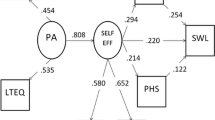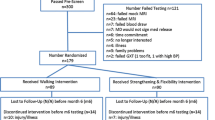Abstract
Using Tai Chi as an exercise mode, this study examined the association between self-efficacy and physical function. Ninety-four healthy, physically inactive older adults (M age = 72.8 years, SD = 5.1) were randomly assigned to either a 6-month, twice a week, Tai Chi condition or a wait-list control condition. Outcome variables included self-reports of movement efficacy and physical function assessed at baseline, middle, and termination of the study. Multisample latent curve analyses revealed a significant rate of change attributable to the Tai Chi intervention in both self-efficacy and physical function, with participants experiencing significant improvements over the course of the intervention. Analyses also showed a positive association between self-efficacy and physical function, indicating that improvements in older adults' self-efficacy of movement as a function of Tai Chi were related to increased levels of perceived physical capability. This study uncovered the need for further exploration of the relationship between exercise self-efficacy and physical function for enhancing health-related quality of life in older adults.
Similar content being viewed by others
REFERENCES
Bandura, A. (1986). Self-efficacy mechanism in human agency. American Psychologist, 37, 122–147.
Bandura, A. (1997). Self-efficacy: The exercise of control. NewYork: Freeman.
Blair, S. N., & Connelly, J. C. (1996). How much physical activity should we do? The case for moderate amounts and intensities of physical activity. Research Quarterly for Exercise and Sport, 67, 193–205.
Blair, S. N., & Garcia, M. E. (1996). Get up and move: A call to action for older men and women. Journal of the American Geriatrics Society, 44, 599–600.
Cohen, J. (1977). Statistical power analysis for the behavioral sciences. Hillsdale, NJ: Erlbaum.
Cress, M. E., Buchner, D. M., Questad, K. A., Esselman, P. C., deLateur, B. J., & Schwartz, R. S. (1999). Exercise: Effects on physical functional performance in independent older adults. Journal of Gerontology: Medical Sciences, 54A, M242–M248.
Federal Interagency Forum on Aging Related Statistics. (2000). Older Americans 2000: Key indicators of well-being. Hyattsville, MD: Author.
Hedeker, D., & Gibbons, R. D. (1997). Application of randomeffects pattern-mixture models for missing data in longitudinal studies. Psychological Methods, 2, 64–78.
Jette, A. M., Jette, D. U., Ng, J., Plotkin, D. J., Bach, M. A., & The Musculoskeletal Impairment (MSI) Study Group. (1999). Are performance-based measures sufficiently reliable for use in multicenter trials. Journal of Gerontology: Medical Sciences, 54A, M3–M6.
J ¨ oreskog, K. G., & S ¨ orbom, D. (1996). LISREL 8: User's Reference Guide. Chicago: Scientific Software International.
Lachman, M. E., Jette, A., Tennstedt, S., Howland, J., Harris, B. A., & Peterson, E. (1997). A cognitive–behavioral model for promoting regular physical activity in older adults. Psychology, Health and Medicine, 1, 251–261.
Lachman, M. E., Ziff, M. A., & Spiro, A. (1994). Maintaining a sense of control in later life. In R. Abeles, H. Gift, and M. Ory (Eds.), Aging and quality of life (pp. 116–132). New York: Sage.
Laird, N. M., & Ware, J. H. (1982). Random-effects models for longitudinal data. Biometrics, 38,963–974.
Lan, C., Chen, S. Y., Lai, J. S., & Wong, M. K. (1999). The effect of Tai Chi on cardiorespiratory function in patients with coronary artery bypass surgery. Medicine and Science in Sports and Exercise, 31, 634–638.
Lan, C., Lai, J. S., Chen, S. Y., & Wong, M. K. (1998). 12-month Tai Chi training in the elderly: Its effect on health fitness. Medicine and Science in Sports and Exercise, 30, 345–351.
Li, F., Duncan, T. E., Duncan, S.C., McAuley, E., Chaumeton, E., & Harmer, P. (2001a). Enhancing the psychological well-being of elderly individuals through Tai Chi exercise: A latent growth curve analysis. Structural Equation Modeling, 8, 53–83.
Li, F., Harmer, P., Chaumeton, N., Duncan, T. E., & Duncan, S. C. (in press). Tai Chi as a means to enhance self-esteem: A randomized controlled trial. Journal of Applied Gerontology.
Li, F., Harmer, P., McAuley, E., Duncan, T. E., Duncan, S. C., Chaumeton, N., & Fisher, J. (2001b). An evaluation of the effects of Tai Chi on physical function among older persons: A randomized controlled trial. Annals of Behavioral Medicine, 23, 139–146.
Li, F., McAuley, E., Harmer, P., Duncan, T. E., & Chaumeton, N. (2001c). Tai Chi enhances self-efficacy and exercise behavior in older adults. Journal of Aging and Physical Activity, 9, 161–171.
Little, R. J. A. (1993). Pattern-mixture models for multivariate incomplete data. Journal of the American Statistical Association, 88, 125–133.
Little, R. J. A. (1995). Modeling the drop-out mechanism in repeated-measures studies. Journal of the American Statistical Association, 90, 1112–1121.
Maddox, G. L., & Clark, D.O. (1992). Trajectories of functional impairment in later life. Journal of Health and Human Behavior, 33, 114–125.
Mardia, K. V. (1970). Measures of multivariate skewness and kurtosis with applications. Biometrika, 57, 519–530.
Mazzeo, R. S., Cavanagh, P., Evans, W. J., Fiatarone, M., Hagberg, J., McAuley, E., & Startzell, J. (1998). American College of Sports Medicine position stand on Exercise and Physical Activity for older adults. Medicine and Science in Sports and Exercise, 30, 992–1008.
McAuley, E. (1993). Self-efficacy, physical activity, and aging. In J. Kelly (Ed.), Activity and aging (pp. 187–205). London, Newbury Park, California: Sage Publications.
McAuley, E., Courneya, K. S., & Lettunich, J. (1991). Effects of acute and long-term exercise on self-efficacy response in sedentary, middle-aged males and females. The Gerontologist, 31, 534–542.
McAuley, E., & Katula, J. (1998). Physical activity interventions in the elderly: Influence on physical health and psychological function. In R. Schulz, G. Maddox, and M. P. Lawton (Eds.), Annual review of gerontology and geriatrics (pp. 115–154). New York: Springer.
McAuley, E., Katula, J., Mihalko, S. L., Blissmer, B., Duncan, T. E., Pena, M., & Dunn, E. (1999). Mode of physical activity and self-efficacy in older adults: A latent growth curve analysis. Journal of Gerontology: Medical Sciences, 54, 283–292.
McAuley, E., & Mihalko, S. L. (1998). Measuring exercise-related self-efficacy. In J. J. Duda (Ed.), Advancements in sport and exercise psychology measurement (pp. 371–390). Morgantown, WV: Fitness Information Technology.
McAuley, E., Mihalko, S. L., & Rosengren, K. (1997). Self-efficacy and balance correlates of fear of falling in the elderly. Journal of Aging and Physical Activity, 5, 329–340.
McAuley, E., & Rudolph, D. (1995). Physical activity, aging, and psychological well-being. Journal of Aging and Physical Activity, 3, 67–96.
Mendes De Leon, C. F., Seeman, T. E., Baker, D. I., Richardson, E. D., & Tinetti, M. E. (1996). Self-efficacy, physical decline, and change in functioning in community-living elders: A prospective study. Journal of Gerontology: Psychological Science, 51, S183–S190.
Meredith, W., & Tisak, J. (1990). Latent curve analysis. Psychometrika, 55, 107–122.
Muthén, B., & Curran, P. (1997). General growth modeling with interventions: A latent variable framework for analysis and power estimation. Psychological Methods, 2, 371–402.
Muthén, K., & Muthén, B. (1998). Mplus: User's guide. Los Angeles, CA: Muthén & Muthén.
National Institute on Aging. (1996, May). Tai Chi for older people reduces falls, may help maintain strength Bethesda, MD: National Institute on Aging. (Press release archive. URL: http://www.hih.gov/nia/new/press/taichi.htm)
Pate, R. R., Pratt, M., Blair, S. N., et al. (1995). Physical activity and public health: A recommendation from the Centers for Disease Control and Prevention and the American College of Sports Medicine. Journal of American Medical Association, 273, 402–407.
Reuben, D. B., & Siu, A. L. (1990). An objective measure of physical function of elderly outpatients: The Physical Performance Test. Journal of American Geriatrics Society, 38, 1105–1112.
Rodin, J. (1986). Aging and health: Effects of the sense of control. Science, 223, 1271–1276.
Rosengren, K. S., McAuley, E., & Mihalko, S. L. (1998). Gait adjustments in older adults: Activity and efficacy influences. Psychology and Aging, 13, 375–386.
SAS Institute. (1990). SAS/STAT software: Changes and enhancements through Release 6.12. Cary, NC: SAS Institute Inc.
Select Committee on Aging,U. S. House of Representatives. (1992). Aging research: Benefits outweigh the costs (Publ.No. 102-871). Washington, DC: U. S. Government Printing Office.
Shephard, R. J. (1997). Aging, physical activity, and health. Champaign, IL: Human Kinetics.
Stewart, A. L., Hays, R. D., & Ware, J. E. (1988). The MOS Short-Form General Health Survey: Reliability and validity in a patient population. Medical Care, 26, 724–735.
Stone, R. I., & Murtaugh, C. M. (1990). The elderly population with chronic functional disability: Implication for home care eligibility. Gerontologist, 30, 491–496.
Tinetti, M. E., Mendes De Leon, C. F., Doucette, J. T., & Baker, D. I. (1994). Fear of falling and fall-related efficacy in relationship to functioning among community-living elders. Journal of Gerontology, 49, M140–M147.
Tinetti, M. E., Richman, D., & Powell, L. (1990). Fall efficacy as a measure of fear of falling. Journal of Gerontology: Psychological Sciences, 45,P239–P243.
Tinetti, M. E., Speechley, M., & Ginter, S. F., (1988). Risk factors for falls among elderly persons living in the community. New England Journal of Medicine, 319, 1701–1707.
Tse, S., & Bailey, D.M. (1991). T'ai Chi and postural control in the well elderly. American Journal of Occupational Therapy, 29, 263–288.
U.S. Department of Health and Human Services. (1996). Physical activity and health: A report of the Surgeon General. Atlanta, GA: U.S. Department of Health and Human Services, Centers for Disease Control and Prevention, National Center for Chronic Disease Prevention and Health Promotion.
Ware, J. E., Snow, K. K., Kosinski, M., & Gandek, B. (1993). SF-36 Health Survey manual and interpretation guide. Boston, MA: The Health Institute, New England Medical Center.
Washburn, R. A., Smith, K. W., Jette, A. M., & Janney, C. A. (1993). The Physical Activity Scale for the Elderly (PASE): Development and evaluation. Journal of Clinical Epidemiology, 46, 153–162.
Wolf, L. S., Barnhart, H. X., Kutner, N. G., Coogler, C., Xu, T., & Atlanta FICSIT Group. (1996). Reducing frailty and falls in older persons: An investigation of Tai Chi and computerized balance training. Journal of American Geriatrics Society, 44, 489–497.
Wolf, S. L., Kutner, N. G., Green, R. C., & McNeely, E. (1993). The Atlanta FICSIT Study: Two exercise interventions to reduce frailty in elders. Journal American Geriatrics Society, 41, 329–332.
Wolfson, L., Whipple, R., & Derby, C. (1996). Balance and strength training in older adults: Intervention gains and Tai Chi maintenance. Journal of American Geriatrics Society, 44, 498–506.
Yan, J. H., & Downing, J.H. (1998). Tai Chi:Analternative exercise form for seniors. Journal of Aging and Physical Activity, 6, 350–362.
Young, D. R., Appel, L. J., Jee, S. H., & Miller, E. R. III. (1999). The effects of aerobic exercise and T'ai Chi on blood pressure in older people: Results of a randomized trial. Journal of American Geriatrics Society, 47, 277–284.
Author information
Authors and Affiliations
Rights and permissions
About this article
Cite this article
Li, F., Harmer, P., McAuley, E. et al. Tai Chi, Self-Efficacy, and Physical Function in the Elderly. Prev Sci 2, 229–239 (2001). https://doi.org/10.1023/A:1013614200329
Issue Date:
DOI: https://doi.org/10.1023/A:1013614200329




